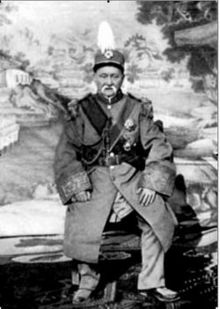Ma Fuxing
Ma Fuxing 馬福興 | ||
|---|---|---|
 | ||
| Tao-yin of Kashgar | ||
| In office 1916–1924 | ||
| Succeeded by | Ma Shaowu | |
| Personal details | ||
| Born | 1864 Hanyu Pinyin Mǎ Fúxīng | |
| other Mandarin | ||
| Xiao'erjing | ﻣَﺎ ﻓُﻮْ سٍ | |
Ma Fuxing (Chinese: 馬福興; Ma Fu-hsing in Wade Giles; 1864–1924) was a Hui born in Yunnan, in Qing dynasty China. He was an ex-convict. During Yang Zengxin's reign in Xinjiang, Ma was appointed as a military commander, and then Titai of Kashgar.[1]
Ma Fuxing served as a general for the
After the fall of the Qing dynasty he started working for Yang Zengxin and recruited Dungan troops for him in 1911, and was posted in 1916 to Kashgar. In 1924 Yang intercepted some correspondence between Ma and the
Ma Fuxing was appointed as the commander of 2,000 Hui soldiers by Yang Zengxin.[3]
Reign
Downfall
Yang Zengxin decided that Ma's excesses were too great, and sent Ma Shaowu, another Hui military commander, to attack and replace him.[6]
Ma Shaowu attacked Ma Fuxing, and then personally executed him by shooting him after receiving a telegram from Yang Zengxin. Ma Fuxing's body was tied to a cross to be put on display.
See also
References
- ^ Mary Patricia Joan Rouse (1992). Search for a New Dominion: Revolt and Rebellion in Xinjiang, China, During the Republican Period, 1911-1949. Ithaca: Cornell University. p. 77. Retrieved June 28, 2010.
- ^ a b Garnaut, Anthony. "From Yunnan to Xinjiang:Governor Yang Zengxin and his Dungan Generals" (PDF). Pacific and Asian History, Australian National University). p. 106. Archived from the original (PDF) on March 9, 2012. Retrieved July 14, 2010.
- ISBN 978-0-231-13924-3. Retrieved June 28, 2010.
- ISBN 0-8135-3533-6. Retrieved June 28, 2010.
- ISBN 0-521-25514-7. Retrieved June 28, 2010.
- ISBN 0-521-25514-7. Retrieved June 28, 2010.
- ISBN 9780813535333. Retrieved June 28, 2010.
